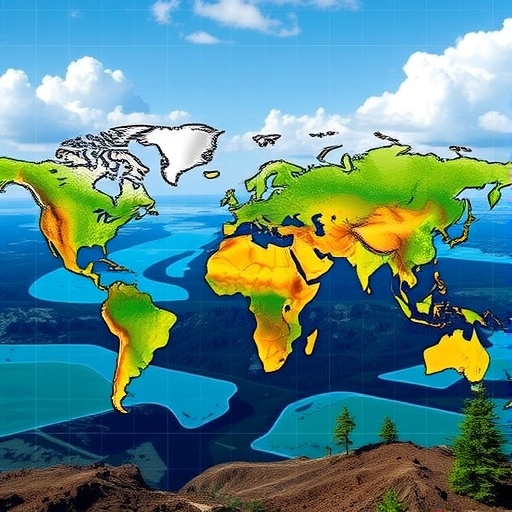A Decade After Paris: New Revelations Expose Alarming Shifts in Carbon Sequestration and Emissions
Ten years following the landmark Paris Agreement, the global landscape of carbon dioxide (CO₂) emissions reveals a stark and troubling reality. Despite international commitments aimed at curbing greenhouse gas outputs, fossil fuel emissions continue their relentless ascent, propelling atmospheric CO₂ concentrations to an unprecedented 423 parts per million (ppm) as of 2024. This surge in atmospheric CO₂ levels has driven global temperatures up by approximately 1.36°C above pre-industrial levels—a threshold dangerously close to the critical 1.5°C warming limit that climate scientists warn must not be exceeded to avoid catastrophic climate impacts.
A cornerstone of effective climate policy hinges on precise quantification of CO₂ sources and sinks—both anthropogenic and natural. However, persistent discrepancies between reported emissions and established carbon sinks have long hindered accurate interpretation of observed carbon fluxes and trends. This has fueled uncertainty surrounding the effectiveness of mitigation strategies and complicated efforts to anticipate carbon sink responses in the evolving climate system.
Groundbreaking research recently published in Nature delivers an integrated evaluation of the global carbon budget, leveraging cutting-edge observational data and enhanced process-based understanding. Crucially, the study reveals a significant downward revision of the magnitude of the terrestrial natural carbon sink. Contrary to earlier assessments, this sink—a key element in offsetting human emissions—is substantially smaller, indicating that land ecosystems absorb less CO₂ than previously believed.
Equally notably, revisions to emissions from anthropogenic land-use change have been adjusted upward. Deforestation, agricultural expansion, and other land transformation activities contribute an even greater volume of net CO₂ emissions than formerly accounted for. This rebalancing reshapes our comprehension of how land-use dynamics interweave with the atmosphere’s carbon content, with profound implications for land management and conservation strategies.
Meanwhile, the ocean’s role as a carbon sink emerges even more prominent than anticipated. Evidence from a suite of oceanic and atmospheric measurements confirms that the oceanic uptake of CO₂ is approximately 15% larger than terrestrial uptake. The oceans continue to act as a vital buffer against climate change by sequestering immense quantities of carbon, but this mechanism is not without limits—a reality underscored by the growing stressors imposed by warming waters and acidification.
Compounding these shifts is a telling influence of climate change itself on sink efficiency. The research quantifies that anthropogenic climate warming has diminished the ability of natural sinks, particularly those on land, to absorb CO₂. Since 1960, this degradation of sink function has directly contributed an estimated 8.3 ± 1.4 ppm increase to atmospheric CO₂ concentrations, highlighting a positive feedback loop where warming accelerates emissions by undermining nature’s carbon storage capacity.
This feedback manifests dramatically in tropical forest regions. Southeast Asia and extensive swathes of the Amazon basin have transitioned from net carbon sinks to net carbon sources, driven by the interconnected forces of climate stress and sustained deforestation. The biochemical and physiological stresses imposed by climate warming destabilize these once robust carbon reservoirs, leading to the release, rather than sequestration, of CO₂.
Consequently, the findings underscore an urgent imperative to halt deforestation and aggressively curb ongoing planet-warming processes. Protecting forested territories is no longer solely a matter of conserving biodiversity or safeguarding indigenous livelihoods—it is a critical frontline defense against irreversible losses in terrestrial carbon storage that would exacerbate the climate crisis.
This comprehensive reassessment of the global carbon budget not only enriches scientific understanding but also equips policymakers with more accurate, actionable insights. Recognizing the diminished buffering capacity of natural sinks and the heightened emissions from land-use change recalibrates the scope and ambition required of mitigation policies. It demands a reimagined framework that integrates robust conservation, restoration efforts, and systemic reductions in fossil fuel dependency.
The urgency of these insights cannot be overstated. As humanity approaches the precarious threshold of 1.5°C warming, refined quantification of carbon fluxes emerges as an indispensable tool for navigating the pathway toward climate stabilization. Without enhanced fidelity in tracking sources and sinks, the efficacy of international commitments and climate agreements remains vulnerable to uncertainty and unfulfilled ambitions.
These revelations also highlight the intricate interplay of anthropogenic activities, natural system responses, and feedback mechanisms within the Earth system. The rising CO₂ levels reflect not only increased emissions but also the weakening resilience of natural systems that historically mitigated atmospheric buildup. Addressing climate change thus requires a holistic approach recognizing these dynamic interactions.
In closing, the study functions as a clarion call for intensified scientific observation, with improved monitoring methodologies essential to inform adaptive, evidence-based climate action. The evolving carbon budget portrays a system under stress—one in which the natural safeguards erode as human interventions intensify, endangering the global climate balance.
Only with concerted, science-driven strategies, incorporating conservation, emission reduction, and restoration, can the global community hope to avert the most severe consequences of climate change. This new understanding of carbon sinks and sources lays a foundation to refine and elevate these efforts, galvanizing a more urgent and informed response in the face of a warming world.
Article References:
Friedlingstein, P., Le Quéré, C., O’Sullivan, M. et al. Emerging climate impact on carbon sinks in a consolidated carbon budget. Nature (2025). https://doi.org/10.1038/s41586-025-09802-5
Tags: anthropogenic versus natural carbon sinksatmospheric CO2 concentration levelscarbon flux discrepanciescarbon sequestration strategiesclimate change impact on carbon sinksclimate policy effectiveness evaluationfuture climate mitigation challengesglobal carbon emissions trendsgreenhouse gas emissions analysisintegrated global carbon budget researchParis Agreement outcomestemperature rise and climate thresholds





